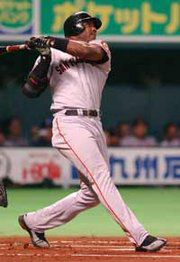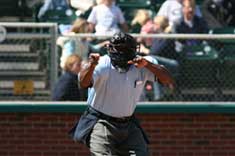
Batting Situation 1: The batter does not swing his bat at the baseball
 |
First let's assume the pitcher delivers the baseball and the batter does not swing his bat at it.
a) If the umpire rules that the pitch is outside of the strike zone, it's bad for the pitcher and good for the batter, because if it happens four times (not necessarily in a row), the batter gets to walk unhindered to first base. Remember, we're assuming the batter doesn't try to swing his bat at these four pitches.
The penalty on the pitcher (and, of course, his team) for not giving the batter enough of a chance to hit the baseball is called, fittingly, a walk. It is also called a base on balls because each such errant pitch is called, believe it or not, a ball. To avoid confusion, this book calls the physical object the "baseball" (even though it is more common to refer to it as the "ball"). Remember: Four balls to a walk.
b) If the pitch enters the strike zone (according to the umpire) and the batter doesn't swing the bat, the tables are turned: bad for the batter and good for the pitcher because if it happens three times, the batter has made an out ("the batter is out"). He has to sit down and await his next turn at bat. This pitch is called a strike ... even though the batter didn't strike at it with his bat. He should have! After all, the strike zone is the area where most people find it easiest to hit a baseball or softball. Remember: Three strikes and you're out.
Batting Situation 2: The batter swings his bat, but misses the baseball.
 |
| An umpire calling a pitch a strike somewhat flambouantly |
When he swings and misses, he's penalized whether or not the umpire would have ruled that the pitch was in the strike zone. That makes sense: he's in a battle with the pitcher, and he's made a mistake. This is another variety of strike and it's added to all the strikes of all the varieties that he incurrs in this time at bat. If they all add up to three strikes, he's out.



